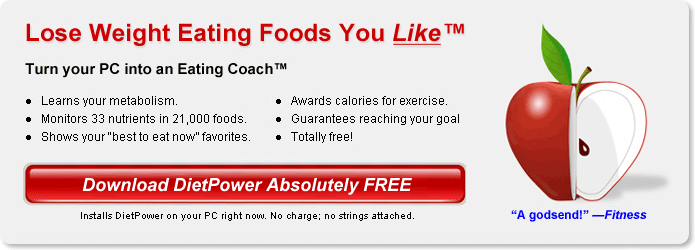What the Heck Is Saturated Fat?
By Terry Dunkle, DietPower Editor-in-Chief
 Hot-fudge-sundae fat is mainly saturated.
Hot-fudge-sundae fat is mainly saturated.
Most of us have heard the term saturated fat all our lives without understanding it. How can fat be "saturated?"
Does that mean it's soaking wet? And is unsaturated fat dry? And if so, is polyunsaturated fat dry in multiple ways?
Let's clear this up right now. It's a sin to go through life ignoring facts that could prevent a heart attack or cancer.
Fats in General
Fat molecules are chains of carbon atoms with hydrogen atoms along their sides like legs on a centipede.
(Remember this. It's the only chemistry you'll need here.)
Fat is also one of the four "energy nutrients," along with carbohydrates, proteins, and alcohol.
Energy nutrients provide calories, which power your brain (25 watts, in most of us) and muscles
(many watts if you're Lance Armstrong) so that you can solve quadratic equations and wax your Pathfinder.
Fat is a wonderful medium for storing energy. A gram of fat (about a quarter-teaspoon) contains nine calories,
versus only four calories in a gram of protein or carbohydrate. (Alcohol contains seven calories per gram,
which means it's an excellent source of energy if you can live with the shide effectsh.)
Yes, some fats are bad for you. We'll get to that.
Saturated Fat
Whenever a fat molecule has all the hydrogen atoms it can accept, it is said to be "saturated." Think of it as the centipede wearing all 50 pairs of its shoes.
Most saturated fats are solid at room temperature. (There goes my "wet" theory -- saturated fats actually feel
drier.)
They also tend to come from animal foods: butter, meat, eggs, and Slim Jims.
Because saturated fats raise blood cholesterol levels and contribute to heart disease and stroke, most experts recommend getting no more than 10 percent
of your calories from such fats. DietPower's weight and nutrition coaching software sets your Personal Daily Allowance (PDA) of saturated fat at this level, but you can
raise it if you think having a stroke might be fun.
Saturated fats have also been implicated in certain kinds of cancer, including breast cancer.
Polyunsaturated Fat
In a polyunsaturated fat, the centipede has at least two pairs of shoes missing, and sometimes many more.
Most polyunsaturates are liquid at room temperature. Most also come from vegetables. You know them as corn oil, peanut oil, and Pam.
Because polyunsaturates have a relatively neutral effect on blood-cholesterol levels, they are much preferred over saturated fats.
There's a hitch, though. We'll explain that in a minute.
Monounsaturated Fat
 In a monounsaturated fat, the centipede is missing exactly one pair of shoes. (They're under the couch somewhere, I'll bet.)
This is a peculiar state that apparently gives the fat wonderfully salutary properties—otherwise, we would also be hearing
TV commercials extolling the benefits of di- or triunsaturated fats.
In a monounsaturated fat, the centipede is missing exactly one pair of shoes. (They're under the couch somewhere, I'll bet.)
This is a peculiar state that apparently gives the fat wonderfully salutary properties—otherwise, we would also be hearing
TV commercials extolling the benefits of di- or triunsaturated fats.
The best known monounsaturated fat is olive oil, but according to the PowerFoods function in DietPower, the richest sources are
oleic safflower oil and macadamia nuts. (Most nuts are rich in monounsaturates.)
Although many people think all fats are bad, monounsaturates can actually protect you against heart disease and stroke by lowering your blood-cholesterol levels.
Therefore, as long as your total fat isn't too high, the more of your fat that's monounsaturated, the better.
(Don't carry this to an extreme, however. You never know what new research might turn up in a few years.)
In general, the American Heart Association recommends getting no more than 30 to 35
percent of your calories from fats and no more than 10 percent from the saturated variety.
Trans Fat
This is the hitch in polyunsaturated fat.
Trans fat is produced when food manufacturers turn vegetable oils into margarine, Crisco, and other products by partially hydrogenating
them—in effect, putting shoes on the centipede so the fat will be solid (or at least gooey) at room temperature.
This is supposed to make butter and lard substitutes that don't clog your arteries.
 In recent years, however, scientists have found that trans fat may slather your pipes just as badly as the moo goo did.
At first, the evidence was weak and provoked heated debate—especially on poker nights between the guys from Land o Lakes
and I Can't Believe It's Not Butter. But today it's clear that people should use butter and margarine only sparingly.
Or better yet, dip your bread in a saucer of olive oil.
In recent years, however, scientists have found that trans fat may slather your pipes just as badly as the moo goo did.
At first, the evidence was weak and provoked heated debate—especially on poker nights between the guys from Land o Lakes
and I Can't Believe It's Not Butter. But today it's clear that people should use butter and margarine only sparingly.
Or better yet, dip your bread in a saucer of olive oil.
In Conclusion
- Keep your fat intake low. (DietPower's Nutrient History is very good for monitoring this.)
- Get most of your fat from plants, not animals.
- Try to avoid foods with hydrogenated on the label.
- Learn to like olive oil and nuts—but don't overdo it.
To comment on this article, .




